As the glory of the summer garden begins to fade, it’s time to roll out the red carpet—or perhaps we should say orange, gold, and crimson—for the stars of the autumn garden. These unsung heroes, the fall-blooming perennials, bring a burst of color, an infusion of fragrance, and a bit of much-needed whimsy to the winding-down garden party. So without further ado, let’s dive into the veritable treasure chest of late bloomers you should be planting in September.
The Stunning Asters: Autumn’s Grand Finale
Every good show needs a grand finale, a spectacular conclusion that leaves the audience in awe. If your garden is the stage, then Asters are the operatic divas belting out the unforgettable closing number in a cacophony of color and life. These stars of the show take center stage just when most other garden performers are wrapping up their roles and preparing for a long winter’s rest.

Asters don’t just bloom; they explode into a riot of color that can rival any summer firework display. The range of their color palette is nothing short of a designer’s dream. From the delicate purity of white and the soft romance of pink to the royal opulence of purple and the soothing calm of blue, Asters add a generous dash of pizazz to any fall landscape. With their bold hues, they illuminate gardens like fireworks against the backdrop of autumn’s typically muted tones, acting like the final resounding notes of a symphony.
It’s not just their vibrant colors that make Asters stand out; their daisy-like flowers are a beacon to all the late-season pollinators. Like us, bees, butterflies, and other insects are trying to soak up every last bit of summer, gathering as much food as they can before the first frosts arrive. A garden filled with Asters is akin to a bustling city that never sleeps, drawing in pollinators like bright lights attract moths.
Perhaps one of the most magical moments you can witness is a Monarch butterfly, nature’s brave little voyager, fueling up for its epic migration on an Aster flower. In this dance of survival, the Aster serves as a little garden gas station, providing sustenance for these delicate creatures about to embark on a remarkable journey.
But Asters don’t just serve a functional purpose; they offer an aesthetic delight as well. Their intricate blooms, with their layered petals surrounding a yellow or brown disc, add textural complexity to the garden. Whether they’re clustered in a bed or used as accents in a mixed border, Asters are guaranteed to turn heads. They’re the encores of the garden, the closing act that ensures the show is memorable long after the curtain has dropped on summer.
So, as we bid farewell to the bountiful summer, let’s celebrate the arrival of these fall divas. Let’s allow Asters to take center stage in our gardens, for they are not merely the supporting cast but the stars of the grand autumnal spectacle. Plant these in September and watch as they transform your garden into a stage worthy of a standing ovation. They are the stunning Asters, after all – the unrivaled queens of the fall garden.
Spectacular Sedums: The Perfect Answer to What to Plant in September?

If you find yourself asking the question, “What to plant in September?”, the answer lies in the spectacular Sedums. These remarkable perennials, particularly the beloved variety known as “Autumn Joy”, are truly the workhorses of the fall garden. Their resilience and beauty make them an ideal choice for gardeners seeking to keep their gardens vibrant even as the temperatures begin to dip.
Sedums bring to mind that one friend we all have – the laid-back companion who’s always calm, never fussy, and gets along with everyone. They’re undemanding, easy-going plants that don’t require pampering or special attention. With their low maintenance requirements, drought tolerance, and adaptability to various soil conditions, Sedums can thrive in your garden like that one friend who’s perfectly content at any social gathering, whether it’s a backyard barbecue or a grand ball.
The true joy of Autumn Joy lies not only in its hardiness but also in its spectacular transformation as the season progresses. When you first plant these in September, you’ll be greeted with mounds of light green, succulent leaves and clusters of tiny green buds. But as they say, patience is a virtue, and Sedums are the embodiment of this proverb. Their true beauty unfolds slowly, like a carefully crafted novel with each chapter more riveting than the last.
As autumn advances, “Autumn Joy” begins its mesmerizing color transformation. The green buds bloom into beautiful pink flowers, bringing a dash of soft color to your fall garden. This stage is akin to the climax of a fireworks display when the skies are filled with dazzling pink bursts of light.
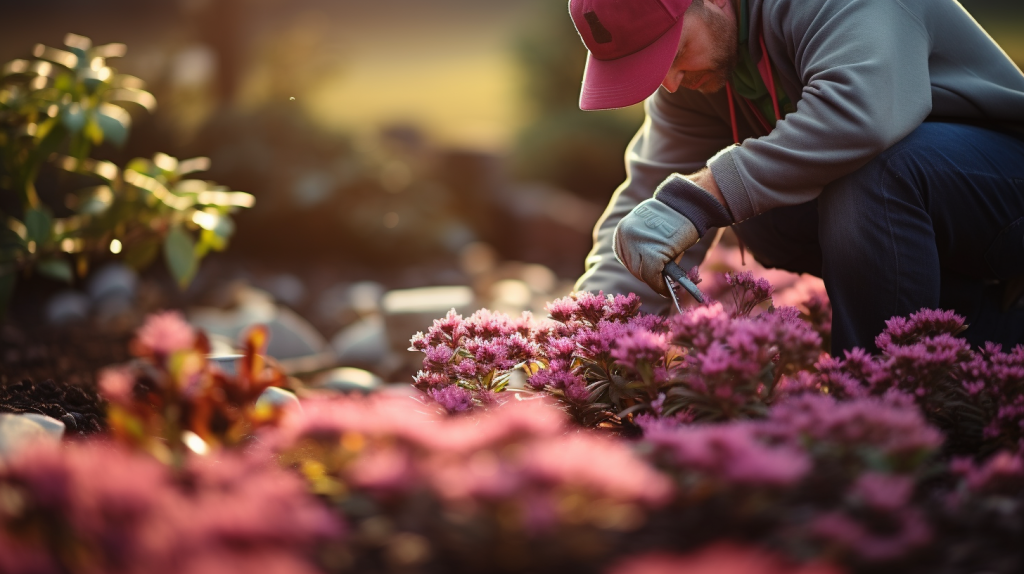
As the season marches on, the pink deepens into a rich, rosy copper. It’s as if nature has taken a paintbrush and dabbed the tops of these plants with strokes of burnished copper. This final color change of Sedums in the garden is nothing short of a slow-burn fireworks display right in your backyard. It’s a fall spectacle that extends the garden season and provides a visual treat for any gardener.
So, as September rolls in and you’re pondering over what to plant, consider the spectacular Sedums. They’re not only a visual delight but also an effortless addition to any fall garden. With their easy care, striking transformation, and prolonged color display, Sedums like the Autumn Joy offer a simple answer to the common question: What to plant in September?
The Resilient Rudbeckias: Fall’s Sunny Blooms

Just when you think your garden has given all it can through the summer, along come the Rudbeckias, the cheerful sunflowers of the fall, ready to take the baton and continue the colorful relay. With their brilliant yellows and deep browns, they are nature’s artists, skillfully capturing the quintessential palette of autumn in their stunning petals. They’re like small, joyous suns that illuminate your garden even on the dreariest of fall days.
The resilient Rudbeckias, commonly known as Black-eyed Susans, are quite the troopers of the plant world. Hailing from the family of sunflowers, they bring the same sunny disposition to the garden but with an added edge of toughness. Just as sunflowers reach for the sky, Rudbeckias rise to every challenge. They don’t just survive in challenging conditions; they thrive, proving that adversity, indeed, reveals genius.

Rudbeckias have that quintessential garden flower look with their bright, daisy-like blossoms. Their golden-yellow petals radiate from a dark, brown-black center, just like the rays of the sun radiating from its core. This distinctive appearance, coupled with their resiliency, makes them a popular choice among gardeners, especially those seeking late-season blooms.
Remember that one aunt who brings her famous casserole to every family function? The one who’s always prepared, rain or shine, and whose dish is the first to disappear from the table? That’s what Rudbeckias are to a garden. They are the dependable and beloved aunt of the plant family. You can count on them to show up and shine, bringing joy and color to your garden when most other plants are ready to call it quits for the year.
So, here’s to the resilient Rudbeckias, the late bloomers who remind us that the end of summer doesn’t mean the end of color in the garden. They carry the warmth of the summer sun into the cooler months of fall, standing tall and shining bright against the changing landscape. With their perseverance and cheerful disposition, they are indeed a welcome addition to the family—oops, I mean, the garden!
Gorgeous Goldenrods: Unfairly Maligned Beauties of Fall
Goldenrods, with their vibrant yellow blooms, are undeniably beautiful. Yet, they often find themselves the subject of an unfortunate misunderstanding. Many people unfairly associate these plants with hay fever, picturing them as botanical villains causing bouts of sneezing and watery eyes. But it’s time to clear the air and exonerate these gorgeous golden bloomers from this unfounded blame.
The Difference Between Goldenrod and Ragweed
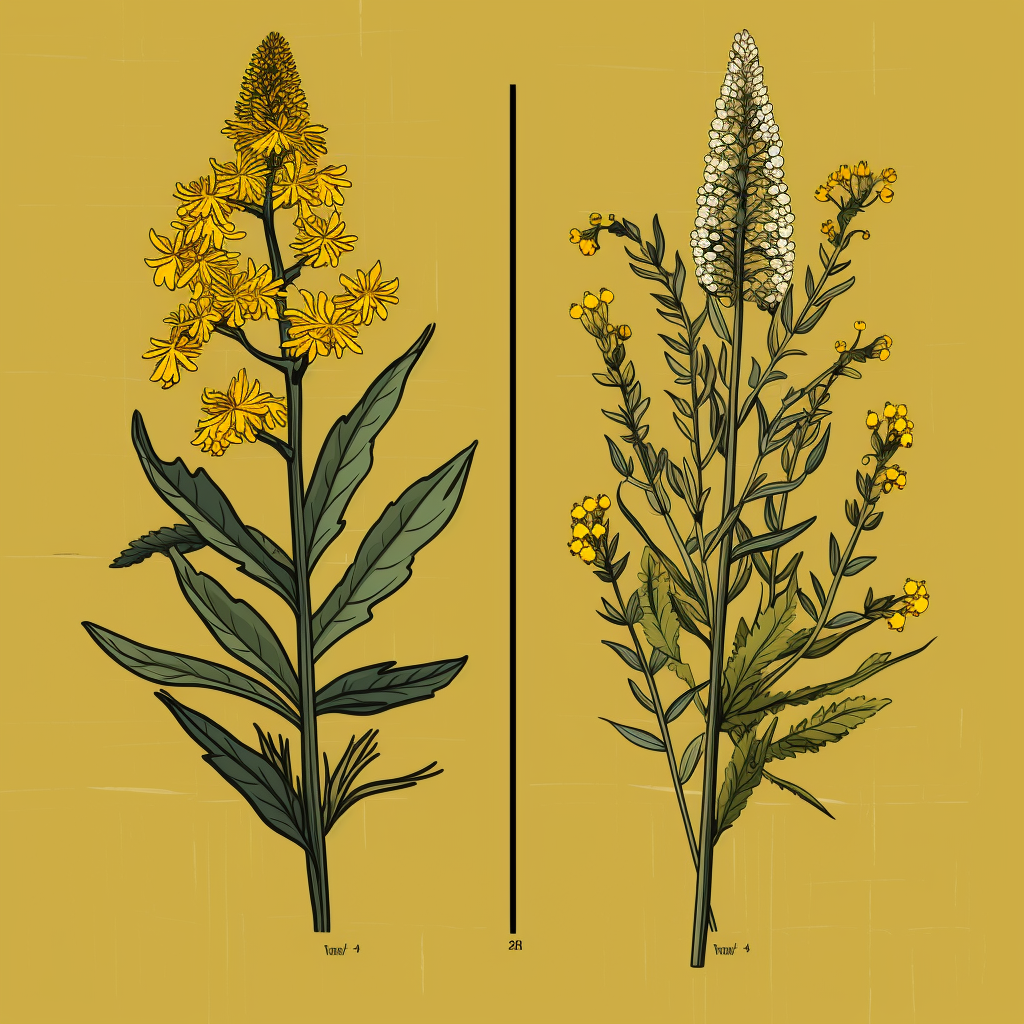
Contrary to popular belief, Goldenrods are not the culprits behind your fall allergies. That dubious honor goes to ragweed, a plant that coincidentally blooms at the same time. The real scenario is somewhat akin to a sibling dynamic where Goldenrods, like a well-behaved sibling, are unfairly blamed for the broken vase, while the actual perpetrator, ragweed, smirks unnoticed in the corner. So, let’s rewrite this narrative and let Goldenrods bask in the limelight they truly deserve.
Goldenrods are more than just bright, vivacious plants adding a pop of color to your fall garden. They are also an excellent source of nectar for insects. As temperatures cool and many nectar sources dwindle, Goldenrods stand tall and inviting, their golden flowers aglow with rich, sugary sustenance. These plants practically set up a buffet for insects, from butterflies and bees to beetles and wasps. And no, there’s no need to picture insects donning tiny bibs and holding tiny forks to appreciate this!
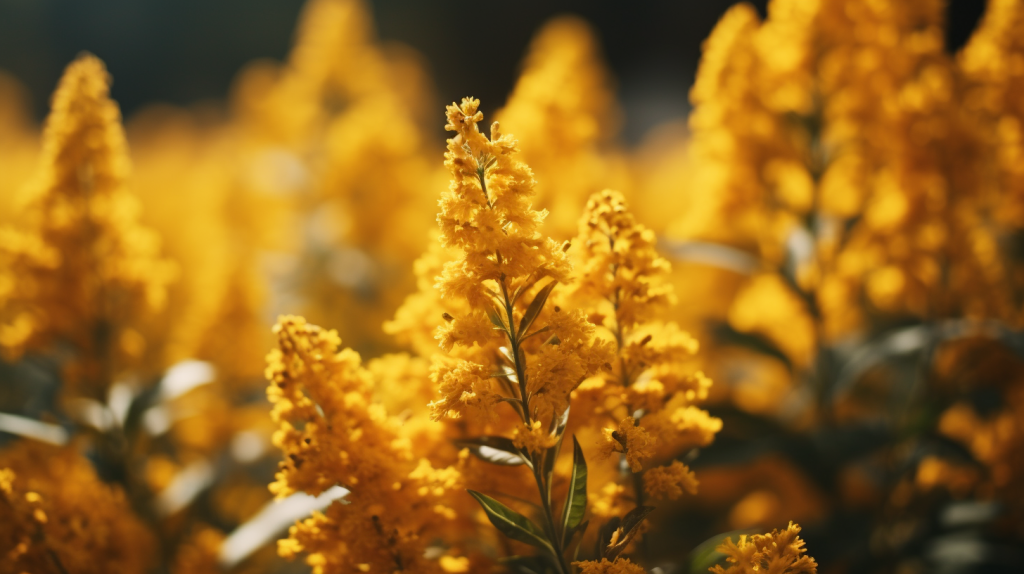
By planting Goldenrods in your garden, you’re creating a haven for these beneficial insects, providing them with nourishment when they need it most. This not only supports the local ecosystem but also adds an element of movement and life to your garden that extends beyond the summer months.
So, as the warm summer days start to cool down and you begin thinking about your fall gardening plans, remember the gorgeous Goldenrods. Give them the recognition they deserve as not just a beautiful addition to the garden, but as beneficial plants that play a critical role in our ecosystem. It’s time to free these vibrant, yellow beauties from the shadows of misconception and let them take their rightful place in the spotlight of your fall garden.
Hardy Heleniums: A Fiery Symphony of Fall Colors
An autumn garden can be a visual feast, and no plant does a better job at contributing to this banquet than the hardy Heleniums. With their fiery hues and vibrant energy, these plants encapsulate the essence of fall like no other.
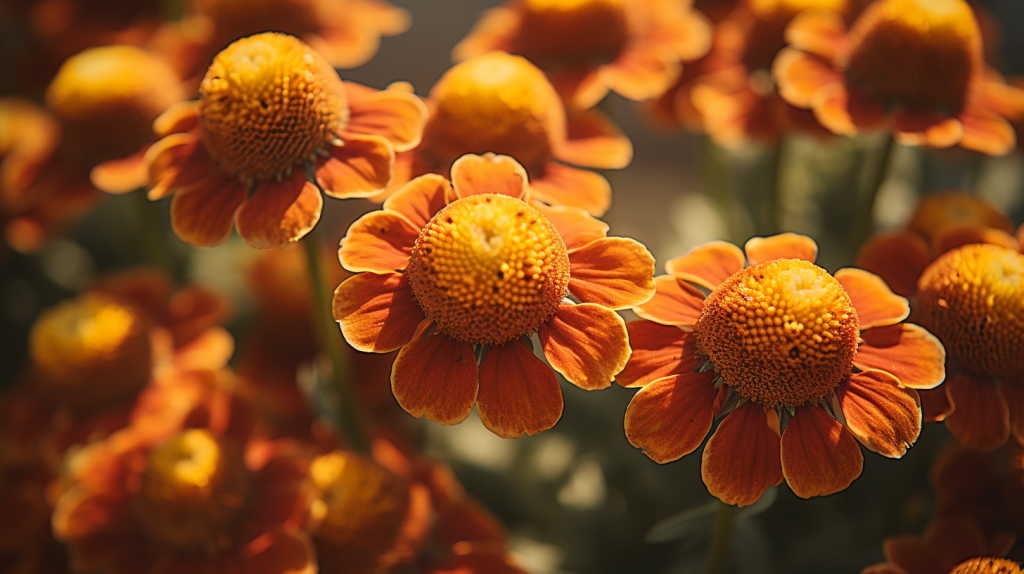
Heleniums, also known as Sneezeweed, are a bit of an anomaly when it comes to their name. Let’s take a moment to debunk a common misconception – despite their nickname, Heleniums do not cause sneezing. It seems that autumn flowers have a knack for being stuck with misleading names. Rest assured, Heleniums can illuminate your garden with their vivid colors without causing a bout of sneezes.
The real charm of Heleniums lies in their warm color palette. With shades ranging from deep red and bright orange to cheerful yellow, they echo the changing colors of the autumn leaves. The effect is a harmonious fall symphony of colors, a seasonal orchestra where each Helenium flower plays a critical note.
Comparatively, Heleniums are like the marching band at a football game. Picture it – a spectacle of perfect coordination, a rousing spirit, and yes, a splash of delightful chaos. The fiery colors of Heleniums dotting your garden landscape create the same kind of engaging visual rhythm, eliciting excitement and appreciation from onlookers.
Heleniums are not just visually impressive; they are also hardy plants. These perennials can withstand different weather conditions and are relatively easy to care for, making them an excellent choice for both beginner and experienced gardeners. They prefer full sun and well-drained soil but can tolerate a range of soil types.
These plants also hold great appeal for pollinators, attracting bees and butterflies that add to the garden’s vitality. By including Heleniums in your garden, you contribute to a biodiverse environment, encouraging pollinators that are crucial for our ecosystem.
In conclusion, as you consider what to plant this September, don’t overlook the hardy Heleniums. With their rich colors, resilience, and appeal to pollinators, these plants are equipped to bring life, vibrancy, and harmony to your autumn garden. They’re the marching band that keeps the spirit alive, the fiery spectacle that signals a grand finale to the growing season. So this fall, let your garden become the football field, let the Heleniums play their rousing tunes, and let the fall symphony begin.
Japanese Anemones: The Graceful Ballet of the Fall Garden
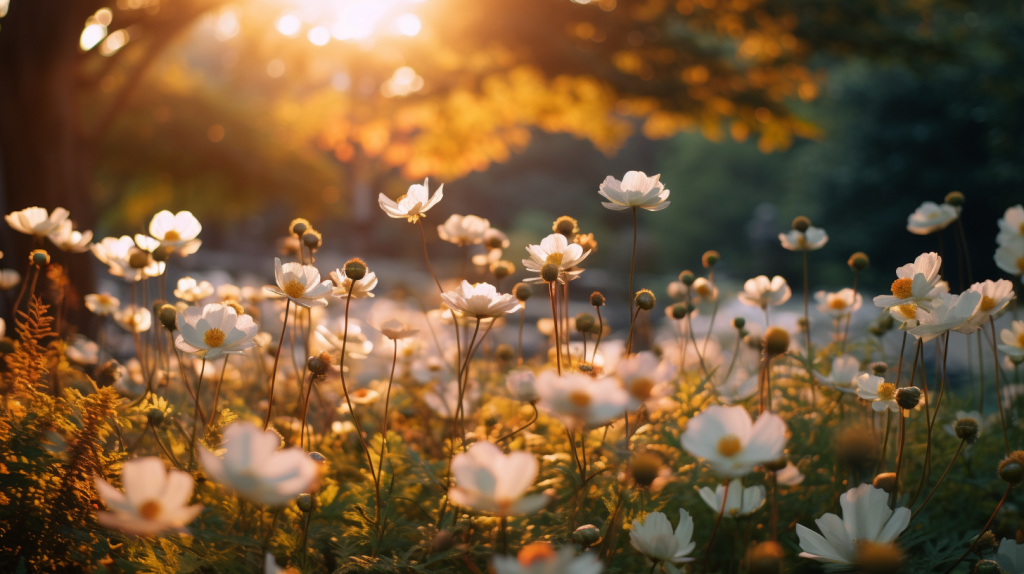
Japanese Anemones, with their delicate, intricate blossoms and tall, slender stems, are the epitome of grace in an autumn garden. These lovely perennials are akin to ballet dancers, their performances captivating and evocative. Their elegance extends from their unique, divided leaves to the charming flowers that cap their stems.
Like dancers, Japanese Anemones sway gently in the wind, their moves guided by the natural rhythms of the environment. Each gust showcases their beautiful pink or white flowers that seem to glow ethereally in the soft autumn light. This gentle swaying and glowing presence offers a comforting, rhythmic dance that can ease the melancholy often associated with summer’s end.
Japanese Anemones are like lighthouses in the garden, their glowing flowers standing tall amid the sea of autumn colors. Their blossoms serve as soft beacons of light, guiding us through the transition of the seasons. This gentle and calming presence makes these flowers an exquisite addition to any fall garden, bringing a touch of serene beauty to the landscape.
These autumn-blooming perennials thrive in partial shade, making them a perfect choice for those garden spots that aren’t bathed in full sun. Despite their delicate appearance, Japanese Anemones are surprisingly resilient, able to withstand the cooler temperatures of fall.
Adding to their charm, Japanese Anemones are also favorites among pollinators. Their open, welcoming blossoms offer easy access to nectar and pollen, making them an excellent late-season food source for bees and other insects.
Caring for Japanese Anemones involves making sure they have well-draining soil and adequate moisture, especially during dry spells. Once established, these perennials require minimal maintenance, allowing you to sit back and enjoy their enchanting autumnal ballet.
In conclusion, as you plan your autumn garden, consider including the ballet dancers of the plant world—the Japanese Anemones. Their graceful swaying, calming presence, and attractive blossoms make them a standout performer in any fall garden. As the days become shorter and the lights of summer begin to fade, let the luminous beauty of Japanese Anemones guide you through the season with elegance and tranquility.
Conclusion
So there you have it, six phenomenal fall-blooming perennials to plant in September. Remember, gardening isn’t just a spring and summer affair. With the right plants, your garden can put on a spectacular show right up until the curtain of winter falls.

And let’s be honest, the fall garden is the underdog, the second act, the encore you didn’t know you needed. It’s your garden’s chance to have the last word, the final flourish, the mic drop. And what could be better than a mic drop in hues of red, orange, yellow, and pink?
Remember: the end of summer doesn’t have to mean the end of color. In the words of Albert Camus, “Autumn is a second spring when every leaf is a flower.” So why shouldn’t your garden follow suit? Happy planting, folks!




